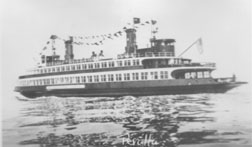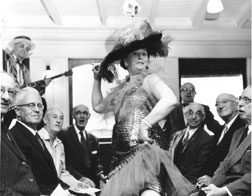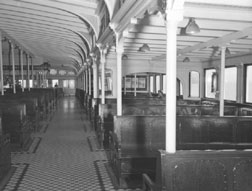A Curmudgeonly Review of the new Alameda
– Oakland ferry Peralta
By Graham Claytor
 |
| The original, ill-fated Peralta |
We can begin with the good things. She’s new. She’s
clean. She’s quieter. She has a historic name, from the old (and
ill-fated) Key System ferry. She has electric heaters on the outside
back deck. She has an occupied lower back deck with seats and a fresh
water wash for bicycles. She has three access points from the top deck
to the lower deck.
However, the designers were completely clueless as to
how a ferry works on the inside. They essentially decided that all
transit users were like BART passengers and traveled in groups of one.
Thus the floor plan allows only a handful of people to sit together. The
upper deck exemplifies this concept. There are exactly four tables for
four people each, which if full, would allow only a few people the
opportunity to sit facing each other and socialize. The back deck is
worse, as each row of bench seats faces outward, toward the water, and
no one faces each other. Then there is an interior section, facing a
bulkhead, dubbed “the movie gallery” by some riders. It has three
rows of nine seats and one row of eight seats facing forward toward the
bulkhead, looking for all the world as if the movie were about to begin.
One of the main differences between ferry services and
other transit services is simply the opportunity to meet your neighbors
and discuss the day’s events. For those who bother to read history,
the 1930 accounts of ferry service reported on the camaraderie that
developed on board, with special holiday events and even live music. The
news stories about the end of the ferries recounted the laments of
passengers and “crying towels” with bits of poetry were handed out
on the last runs. Thus the new Peralta completely ignores history and
has an interior designed to herd the commuters into seats of two, with
few facing each other.
 |
| Commuters cutting the rug.
Ferryriders of yesteryear knew how to have a good time and
ferryboats by their convivial design encouraged social
interaction. Surely, today’s ferryrider’s would welcome the
same opportunity to cut loose. Photo credit: Southern Pacific
Railroad |
There are other flaws. The snack bar is located
inconveniently close to the main entrance, so that the line backs up
into those entering the vessel. And despite years of comments, the
passenger loading system still uses Noah’s biblical design. The
capacity of this two-decked vessel is limited to 330, a number only made
practicable by the dot bombs, layoffs and the recession. This vessel is
also a victim of the currently popular mantra, “The currency of
transit is speed.”
High-speed vessels are more expensive to build,
maintain and operate. Thus the commuter/taxpayer gets less boat for the
money and pays more for the higher operating costs. Further, for
reliable service, there must be at least two boats that can operate at
the same speed, so that when one is down, the other can maintain the
schedule. But the Peralta is a 26-knot vessel, faster than the Encinal
and much faster than the 18-knot Bay Clipper and Flyer. But for all this
speed that we have paid extra for, there will be no schedule
improvements because there is no back up boat with the same
capabilities.
Also, a little, fast ferry on a relatively short run
that can only load two people at a time creates a new transit concept of
taking longer to dock, unload and load at both ends than the entire
crossing. If we were really interested in improving the performance, we
should be looking at dock modifications and wider doors that would
reduce the unproductive dwell time. That would allow larger, slower
vessels with reduced capital costs, higher capacity and lower operating
expenses to use the same schedule we have today. But don’t take this
critic’s word for it, look up Max Ebb’s article in the September
2001 Latitude 38 titled, “Ferry Tales.” He notes that when you
double the size of the ferry, you can cut fuel consumption per passenger
in half (assuming you can fill up the boat). Doubling the speed
increases fuel consumption per passenger by a factor of four (more if
the boat is not full). The maintenance savings of slower revolving
diesels should just be plain obvious.
 |
| Ferryboat Alameda unloading at the
Oakland Mole, the terminus of the transcontinental Southern
Pacific passenger trains, in use until 1958 but by commuters
only until 1939. This view illustrates the twin deck unloading
system that can completely discharge all the passengers on the
vessel – about 1800 people — in less than four minutes. By
contrast, modern ferries, carrying fewer than 400 people, take
eight to ten minutes. Photo credit: Southern Pacific Railway |
Once again we have transit planners ignoring history.
When the Bay was home to real commuter ferries in 1920, some 22,657,418
transbay passengers were carried on large, slower vessels. Yet how slow
is slow? The scheduled running time of Southern Pacific’s Alameda to
San Francisco service was twenty minutes, about what it is today (the
moles were closer to San Francisco and ferries suffered no “slow bells”
in the estuary; docking and unloading took only a few minutes, due to
wide doors and “V” shaped docks). And neither the Alameda nor the
Oakland Mole had a single parking place, for every 32 seconds in rush
hours, a train headed from the mole to take passengers back home in
Oakland.
We had a system that worked extremely well and
actually operated without subsidies. If we could only convince transit
planners to rethink their vision of a fleet of expensive, high-speed,
small ferries zipping around the bay like water spiders, we might
actually come up with a system that would operate efficiently well into
this century.
Overall rating (this was supposed to be a review of
the Peralta): Bad concept; poor execution. It looks like we’ve got yet
another vessel that would be ideal for the Harbor Bay service.
 |
| Typical ferryboat interior from
the Golden Age of San Francisco Bay ferry service. Note
passenger seats facing each other, permitting and encouraging
social interaction. Modern ferryboat favors two-by-two seating,
all facing forward. Photo credit: Southern Pacific Railroad |
Oh, and the history of the original Peralta? She was
completed for the Key System on March 15, 1927 with turbo-electric
engines generating 2,600 indicated horsepower. But bad luck quickly
followed, as dozens of passengers were swept overboard on February 17,
1928 when a ballast tank failed to drain and the passengers surged
forward, dipping the bow under water while nearing the Ferry Building.
Five were killed, making this the worst ferry accident in the history of
San Francisco Bay. Then, while minding her own business on May 6, 1933,
the Key System Pier where she was tied up caught fire, heavily damaging
the Peralta. She was sold for salvage to the Puget Sound Navigation
Company and was rebuilt as the Kalakala, where she then enjoyed years of
service and a bit of notoriety as the World’s only streamlined ferry.
We trust our Peralta will do better, although ours has already suffered
a gear-box failure, taking her out of service for several weeks.